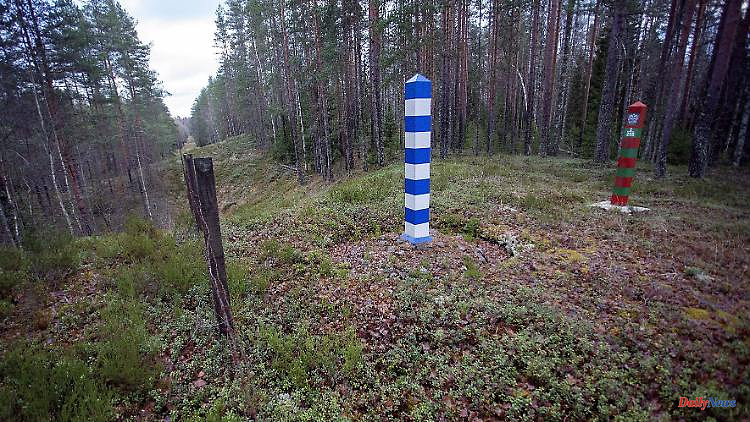In the far north, Finland borders Russia for 1,340 kilometers. After the Russian attack on Ukraine, the Nordic country also wants to join NATO. In military theory, a fiasco for the Kremlin.
No matter how the Kremlin views the Russian attack on Ukraine, one thing that Russian President Vladimir Putin has definitely achieved with his invasion is that the hated NATO is getting bigger. Sweden and Finland want to join the transatlantic defense alliance as soon as possible - out of concern that they could become the next Russian victims.
Finland in particular can relate to how Ukraine is feeling at the moment. The Nordic country has a long and sometimes bloody history with Russia. Some older Finns fought against the Red Army at a young age, in the Winter War of 1939/1940. A good 80 years ago, what was then the Soviet Union wanted to incorporate Finnish territory. The Finns, who were clearly inferior in terms of numbers and materials, put up a good fight and were initially able to stop the attack of the Red Army.
Only after more than two months did the Soviet troops break through. The war ended on March 13, 1940 with the Moscow Peace Treaty. Finland remained independent but had to cede parts of its land.
Since then, the border between the two states has been over 1,300 kilometers long - and for the most part hardly secured. If Russia wanted, its troops could quickly and easily advance to Finland. The invasion of Ukraine proves that the Kremlin is ready for such attacks.
Despite the Turkish threat of veto, Sweden and Finland's accession to NATO is only a matter of time. "Cooperation has existed for a long time, so nothing is changing militarily ad hoc. In the future, however, the Baltic Sea will become a sea dominated by NATO. That of course worsens Russia's geostrategic position," analyzes retired Brigadier General Erich Vad.
Nordic NATO expansion would further isolate Russia and, most importantly, jeopardize Russian dominance in Northern Europe. Not many people live in the extreme north-west of the Russian Federation, but mainly reindeer, moose and arctic foxes. However, the region is rich in mineral resources. There are large deposits of nickel, other heavy metals, ores and precious stones are also abundant.
But above all, the Kola Peninsula is a military center of the Russian army. For decades, the Kremlin has been arming the region. Among other things, a huge nuclear arsenal of the Russian armed forces is stationed on Kola, and the Russian Northern Fleet has its home in the Murmansk region. Russia's only ice-free Arctic port is in Severomorsk, and most of the Russian nuclear submarines are in the Zapadnaya Liza fjord.
The Northern Fleet enjoys "absolute priority" for Moscow, as the German Institute for International and Security Affairs (SWP) analyzed two years ago. It is intended to defend Russia in the event of a nuclear war, because it claims two-thirds of the maritime nuclear second-strike capability - far away from possible conflict opponents.
So far, Russia in Northern Europe only knows a 150-kilometer NATO border in front of its own door. The easternmost tip of Norway borders on Murmansk Oblast in the far north. A military bottleneck that is easy to control. Unlike the Russian-Finnish border, which is ten times as long, although it is completely absurd that Finland would join the defense alliance to attack Russia.
But military theory is not about probabilities, it is about facts. In the case of Kola, from the Russian perspective, the current situation is that the Kremlin sees the Finnish border as a huge gateway into its territory, which can hardly be controlled militarily.
Over a distance of more than 1,300 kilometers, the defensive alliance could deploy troops and inflict severe damage on Russia without much effort. Because the entire peninsula with all its army bases is only connected to the Russian heartland by a single road and railway line. From Nikel, the Russian-Norwegian border town, it is about 950 kilometers to Medweschjegorsk, only here does the highway fork.
Finnish author Tomi Ahonen summed up this mind game on Twitter: "A single company of specialists could destroy the road, railway and power line between Murmansk and the rest of Russia. Then the area would only be forest. Finland would have to." do not occupy."
Of course, a war between Russia and NATO is a purely theoretical construct. But in the eyes of the Kremlin, the transatlantic alliance is also an aggressive military alliance, not a defense pact. For the Putin regime, it's all about geopolitical influence. And this becomes smaller when countries like Sweden or Finland give up their neutral status.
With its policy, Russia has achieved exactly the opposite of what it wanted to achieve, summarizes Markus Kaim from the Science and Politics Foundation. "Russia wanted to contain NATO's influence, divide it, push the US out of Europe. The opposite has happened: NATO is united and we are even seeing a northward expansion. The entire policy of the Russian government towards NATO is a total disaster."
6












